Balbharti Maharashtra State Board Class 11 Geography Solutions Chapter 1 Earth Movements Textbook Exercise Questions and Answers.
Std 11 Geography Chapter 1 Question Answer Earth Movements Maharashtra Board
Class 11 Geography Chapter 1 Earth Movements Question Answer Maharashtra Board
Geography Class 11 Chapter 1 Question Answer Maharashtra Board
1. Complete the chain.
Question 1.
| A | B | C |
| (1) Widespread volcanic eruption | (1) Zone V | (1) I to XII |
| (2) Andaman and Nicobar Islands | (2) Fissure eruption | (2) Block Mountain |
| (3) Mercalli scale | (3) Intensity | (3) Very high seismic vulnerability |
| (4) Slow movements | (4) Faulting | (4) Solid |
| (5) Philippines | (5) Volcanic bombs | (5) Deccan Trap |
| (6) Volcanic material | (6) Circum Pacific belt | (6) Mayon |
Answer:
| A | B | C |
| (1) Widespread volcanic eruption | (1) Fissure eruption | (1) Deccan Trap |
| (2) Andaman and Nicobar Islands | (2) Zone V | (2) Very high seismic vulnerability |
| (3) Mercalli scale | (3) Intensity | (3) I to XII |
| (4) Slow movements | (4) Faulting | (4) Block Mountain |
| (5) Philippines | (5) Circum Pacific belt | (5) Mayon |
| (6) Volcanic material | (6) Volcanic bombs | (6) Solid |
![]()
2. Identify the correct correlation.
A : Assertion R : Reasoning
Question 1.
A – Faulting leads to development of fold mountains.
R – Faulting occurs when tensional forces move away from each other.
(a) Only A is correct.
(b) Only R is correct.
(c) Both A and R are correct and R is the correct explanation of A.
(d) Both A and R are correct but R is not the correct explanation of A.
Answer:
(b) Only R is correct.
Question 2.
A – Intensity of an earthquake is a measurement of the energy released during an earthquake.
R – Mercallis scale is used to measure intensity of an earthquake.
(a) Only A is correct.
(b) Only R is correct.
(c) Both A and R are correct and R is the correct explanation of A.
(d) Both A and R are correct but R is not the correct explanation of A.
Answer:
(c) Both A and R are correct and R is the correct explanation of A.
Question 3.
A – South-East Asia, Japan and islands in the Pacific Ocean are most vulnerable to earthquakes and volcanic eruptions.
R – They are located in ‘Ring of Fire’.
(a) Only A is correct.
(b) Only R is correct.
(c) Both A and R are correct and R is the correct explanation of A.
(d) Both A and R are correct but R is not the correct explanation of A.
Answer:
(c) Both A and R are correct and R is the correct explanation of A.
3. Identify the correct group.
Question 1.
| A | B | C | D |
| (1) Symmetrical Fold | (1) Black Forest | (1) Narmada Valley | (1) Caldera |
| (2) Isoclinal Fold | (2) Vosges | (2) African Valley | (2) Crater Lake |
| (3) Overturned Fold | (3) Himalayas | (3) Tapi Valley | (3) Cinder Cone |
| (4) Recumbent Fault | (4) Satpuras | (4) Rhine Valley | (4) Lava Plateau |
Answer:
C
![]()
4. Give geographical reasons.
Question 1.
Extinct conical volcanoes often form crater lakes.
Answer:
Extinct conical volcanoes often form crater lakes because-
- An extinct volcano had no volcanic eruption for at least 10,000 years and is not expected to erupt again in future.
- After the eruption a large and deep depression remains in that area. Smaller depressions are called craters.
- This crater eventually gets filled with water and crater lakes are formed.
- The water may come from precipitation, ground water circulation or melted ice.
Question 2.
People living in the Himalayas are more vulnerable to earthquakes.
Answer:
People living in the Himalayas are more vulnerable to earthquakes because-
- Himalayan mountain ranges are formed as a result of collision of Indo-Australian plate and Eurasian plate.
- According to plate tectonic theory, Indo-Australian plate (on which India lies) is moving towards north and is subducting under Eurasian plate.
- This movement obviously cause friction between two plates.
- Thus, these regions are more prone to earthquakes.
Question 3.
L-waves do not have a shadow zone.
Answer:
L-waves do not have a shadow zone because-
- The shadow zone is the area of the earth from angular distance of 105° to 140° from a given earthquake for both P-waves as well as S-waves.
- Generally, seismographs located at any distance withinl05° from epicentre record the arrival of S-waves and beyond 140° from epicentre record the arrival of P-waves.
- L-waves are typically generated when the source of the earthquake is close to the earth’s surface.
Question 4.
Soft rocks form folds while hard rocks form faults.
Answer:
Soft rocks form folds while hard rocks form faults because –
- Soft and elastic rocks are affected by compressional forces.
- Rocks that lie deep within the crust and are therefore under high pressure are generally ductile and particularly susceptible to folding without breaking.
- Whereas rock layers that are near the earth’s surface are too rigid to bend into folds.
- If the tectonic force is large enough, these rocks will break rather than bend and faulting on rupture occur.
![]()
Question 5.
Folds depend on the strength of rocks and intensity of forces.
Answer:
Folds depend on the strength of rocks and intensity of forces because-
- The elasticity of rocks largely affects the nature and magnitude of folding process.
- The softer and more elastic rocks are subjected to intense folding while rigid and less elastic rocks are only moderately folded.
- The compressional forces push two portions of the crustal rocks together and tend to shorten and thicken the crust.
- Rocks that lie deep within the crust and are therefore under high pressure are generally ductile and particularly, susceptible to folding without breaking
5. Answer in detail.
Question 1.
Explain different types of faults.
Answer:
A fault is a fracture in the crustal rock, formed when the crustal rocks are displaced due to tensional movement caused by endogenic forces. The displacement of rock can occur in upward, downward or horizontal direction.
The different types of faults determined by the direction of motion are:
Normal fault: It results when a portion of land slide down along the fault plane and when the exposed portion of the plane faces the sky
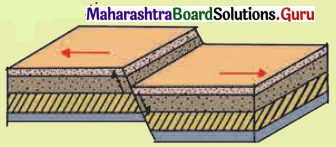
Reverse fault: It results when a portion of the land is thrown upward relative to other side of the land. In such situation, the fault plane faces the ground.

Tear fault: At times, the rock strata on either side of the fault plane do not have vertical displacement. Instead, movement occurs along the plane in horizontal direction.
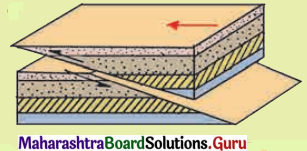
Thrust fault: When the portion of the land on one side of the fault plane gets detached and moves over the land on the other side. The angle of fault plane is generally less than 45°.
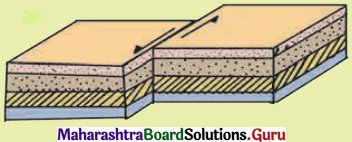
![]()
Question 2.
Explain with examples, different types of landforms produced by volcanic eruption.
Answer:
A number of landforms are formed due to cooling and solidification of magma. Some important landforms are:
Lava domes:
- Domes are developed when magma comes out and solidifies around its mouth.
- The shape of the dome depends upon the fluidity of lava.
- High dome with steep slopes is developed by acidic lava.
- Due to basic lava, broad – based low domes are developed.
Lava plateaus:
- Due to spread of lava in huge quantity from fissure volcano, it covers large areas and plateaus are formed.
- The Deccan Trap in India has developed from volcanic eruptions millions of years ago.
Caldera:
- At times, the eruption of volcano brings about large quantity of material and relieves lot of pressure.
- After the eruption, a large and deep depression remains in that area. This large depression is called caldera.
- These can be around 10 km wide and hundreds of metres deep.
- They may later turn into lakes. Smaller calderas are known as craters.
Crater lake:
When the funnel shaped crater of an extinct volcano gets filled with rain water, it forms a crater lake.
Volcanic plug:
- It is formed when the lava solidifies in the volcanic neck.
- The surrounding rock material is removed by different agents of erosion; the vent stands predominantly. It is called as volcanic plug.
- The diameter of a plug varies between 300 and 600 metres.
- The Devil’s Tower in Wyoming, United States of America is the best example.
Cinder cone:
- Solid material is ejected in large quantity.
- This material consists of ash, cinder and breccias.
- Cinders are half burnt pieces of solid material.
- The solid material is deposited around the mouth until a conical hill with steep slopes is formed.
- For example, cone of Mt. Nuovo in Italy.
Composite cone:
- Composite cones are built up of alternate layers of lave and cinder.
- This cone is composed of two materials and therefore it is called a composite cone.
- It is symmetrical in shape.
- For example, Mt. St. Helens, USA.
![]()
Question 3.
Explain the concept of shadow zone.
Answer:
- The waves which are caused by earthquake are called seismic waves. There are three types of waves: P-waves, S-waves and longitudinal waves.
- P-waves can pass through all the mediums while S-wave can pass only through solid medium.
- Even though P-waves pass through all mediums, they experience refraction as they pass from one medium to the other.
- However, there exist some specific areas where the waves of that earthquake are not reported. Such zone is called ‘shadow zone’.
- Generally, seismographs located at any distance within 105° from the epicentre, record both P-waves and S-wave. However, beyond 140° P-wave are recorded but not S-waves.
- Thus, the zone between 105° and 140° is identified as the shadow zone for both types of waves.
- The entire zone beyond 105° does not receive S-waves. The shadow zone of S-waves is much larger than that of P-waves.
- The shadow zone of P-waves appears as a band round the earth between 105° and 140° away from the epicentre.
Question 4.
Write a note on volcanic materials.
Answer:
There are three main types of material which come out in volcanic eruptions namely liquid, solid and gaseous form.
Liquid material:
- It is the molten rock material. When the molten rock material is below the earth’s surface, it is called ‘Magma’.
- When it appears on the surface it is called ‘lava’. On the basic of percentage of silica, it is classified as:
- Acidic lava : (a) It contains higher percentage of silica, (b) It has high melting point, (c) It is thick, fluid and moves slowly.
- Basic lava : (a) It contains less percentage of silica, (b) It has low melting point, (c) It’s thicker, fluid and can flow over longer distance.
Solid material:
- It consists of dust particles and rock fragments.
- When the material is very fine, it is called volcanic dust.
- The small sized solid particles are called ash.
- The solid angular fragments are known breccias.
- Sometimes, the lava material thrown into the air solidifies into small fragments before falling on the earth’s surface; it is called volcanic bombs.
Gaseous material:
- At the time of volcanic eruption, a dark cloud of smoke can be seen over the crater.
- On the basis of shape, cloud is called cauliflower cloud.
- Various inflammable gases are found in these clouds.
- These gases produce flames.
![]()
6. Differentiate between.
Question 1.
Folding and Faulting.
Answer:
| Folding | Faulting |
| (i) Folds are bends in the rocks that are due to compressional forces. | (i) Faults are formed due to tensional forces along which displacement of rock takes place. |
| (ii) Folding occurs when compressional forces are applied to rocks that are ductile or flexible. | (ii) Faults occurs when force operating in opposite direction lead to tension and as a result rocks develops cracks on fissure. |
| (iii) Rocks that lie deep within the crust and are therefore under high pressure are generally ductile and particularly susceptible to folding without breaking. | (iii) Rock layers that are near the earth’s surface and not under high confining pressures are too rigid to bend into folds, but if tectonic forces are large, rocks break. |
| (iv) Folding leads to development of fold mountain. For e.g., the Himalayas, the Alps, etc. | (iv) Faulting results in the formation of block mountains like black forest mountain etc., and right valleys like the Narmada, Tapi, etc. |
Question 2.
Normal fault and Reverse fault.
Answer:
| Normal fault | Reverse fault |
| (i) It results when a portion of landslides down along the fault plane. | (i) It results when a portion of land is thrown upward relative to other side of the land. |
| (ii) The exposed portion of plane faces the sky. | (ii) The fault plane faces the ground. |
Question 3.
Syncline and Anticline.
Answer:
| Syncline | Anticline |
| (i) As and when limbs slopes towards each other and the central part located at lower elevation forms synclines. | (i) As and when limbs slopes downward with central position getting raised up, it is called anticline. |
| (ii) They form valleys. | (ii) They form the top / peak of the mountain. |
| (iii) They have a greater depth. | (iii) They are of a greater height. |
![]()
Question 4.
Asymmetrical fold and Symmetrical fold.
Answer:
| Asymmetrical fold | Symmetrical fold |
| (i) The axial plane is inclined. | (i) The axial plane is vertical. |
| (ii) Limbs are inclined at different angles. | (ii) Limbs are inclined at same angles. |
| (iii) The height and shape of limbs is not same. | (iii) The height and shape of limbs is same. |
Question 5.
Mercalli scale and Richter scale.
Answer:
| Mercalli scale | Richter scale |
| (i) It measures the intensity of earthquake. | (i) It measures the energy released during an earthquake. |
| (ii) The measurement is based on observed effects. | (ii) The measurement is done with the help of seismograph. |
| (iii) Quantified from observation of the effects on earth’s surface, human beings, objects and man- made structures. | (iii) Quantified from logarithmic scale obtained by calculating logarithm of the amplitude of waves. |
| (iv) Unit of measurement I (not felt) to XII (total destruction) | (iv) Unit of measurement from <2.0 to 10.0 + (never recorded) 3.0 earthquake releases 32 times more energy than a 2.0 earthquake. |
Question 6.
Slow movements and Sudden movements.
Answer:
| Slow movements | Sudden movements |
| (i) Slow movement include both vertical and horizontal movement which are caused due to forces deep within the earth. | (i) Sudden movements are caused by sudden endogenic forces coming from deep within the earth. |
| (ii) These movements are occurring continuously. | (ii) These movement occurs in the form of events. |
| (iii) Slow movements include formation of mountains and continents. | (iii) Sudden movements include event such as earthquakes and volcanoes. |
![]()
7. Draw a neat and labelled diagram.
Question 1.
Types of folds
Answer:

Question 2.
Types of Faults
Answer:
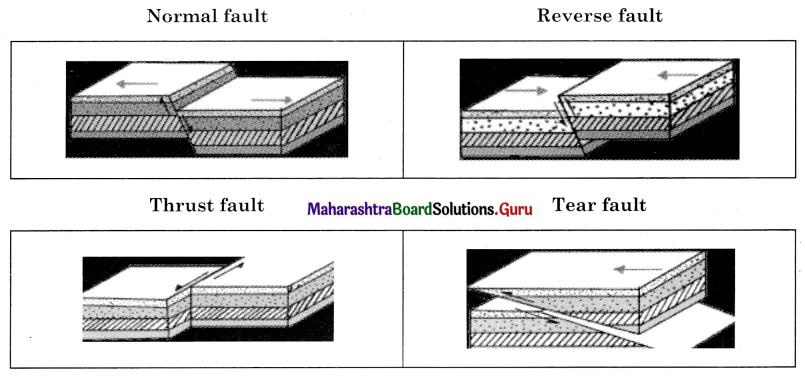
Question 3.
Shadow zone
Answer:

![]()
Question 4.
Volcanic landforms
Answer:
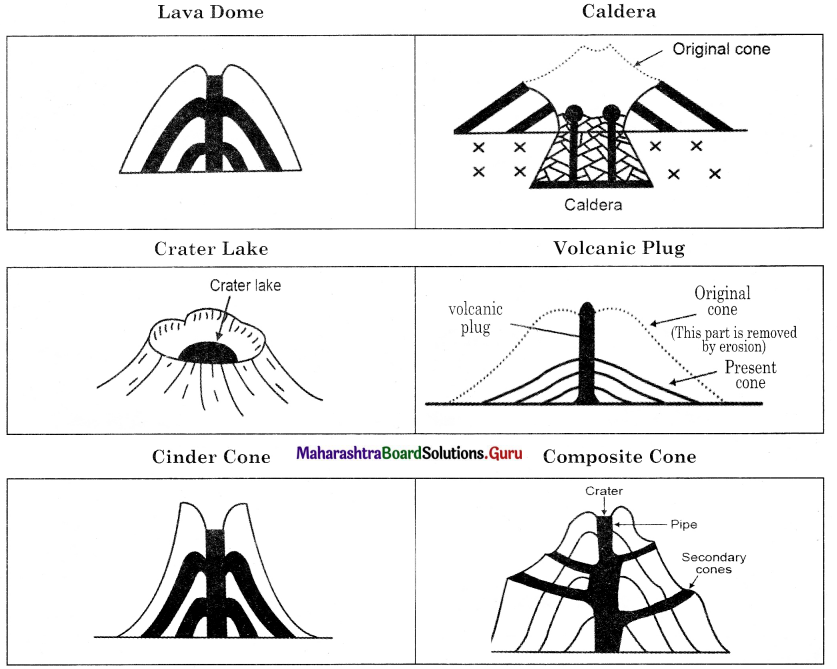
11th Geography Digest Chapter 1 Earth Movements Intext Questions and Answers
Let’s recall (Textbook Page No. 1)
1. Observe the following pictures in fig 1.1 and discuss the questions.

Question 1.
What might be the reasons behind buildings collapsing in photo 1?
Answer:
The major reason behind the buildings collapsing in photo 1 is the occurrence of earthquakes.
Question 2.
Which event in depicted in photo 2? What impact does it bring about in the surroundings?
Answer:
The volcanic eruption and flowing of lava is depicted in photo 2. Heavy loss of life and property is experienced when the lava flows to the surrounding area.
![]()
Question 3.
In photo 3, what could be the reason behind the bend in the rock strata?
Answer:
Due to compression of sediments within the earth’s interior and pressure from overlying layers the rock strata seems to be bended.
Question 4.
What could be the reason behind the difference in altitudes of the land and the steepness of the slope in photo 4?
Answer:
The reason could be displacement of rock due to vertical movement. It may form plateau on block mountains.
Question 5.
Classify the events in the photos into sudden and slow movements.
Answer:
Sudden movements are earthquake and volcanoes in photo 1 and 2. Slow movements are formation of folds and formation of plateaus or block mountains in photo 3 and 4.
Question 6.
Example of which of these movements is not likely to be found in the mainland of Indian sub- continent?
Answer:
The volcanic eruptions are not found in mainland of India sub-continent.
2. On 19th August, 2018, around 300 people died in Indonesia. Many buildings collapsed. Many roads broke apart. A tsunami was generated. (Textbook Page No. 6)
Question 1.
What was the cause behind these events?
Answer:
Collision of tectonic plates was the causes behind the events.
Question 2.
What actually happened during this natural event?
Answer:
A very high intensity earthquake struck north eastern parts of Indonesian coastline, where subsequent landslides into sea triggered tsunamis.
![]()
Question 3.
Name the energy waves involved in this natural event.
Answer:
Tsunamis were involved in this natural event where the tectonic plates moved horizontally.
Question 4.
Observe the diagram in fig. 1.9 and label the boxes.
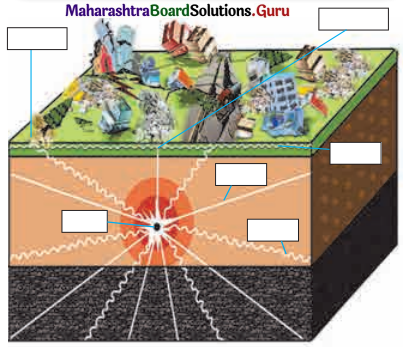
Answer:
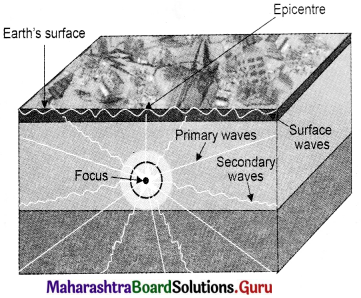
Think about it.
Question 1.
How will compressional forces affect brittle rocks? (Textbook Page No. 3)
Answer:
The compressional forces will break the brittle rocks into pieces.
Question 2.
A mountain never remains a mountain’. Can you relate this idiom with the mountain building process? (Textbook Page No. 4)
Answer:
This happens because of continuous erosional activities taking place on the mountain sides. Running water glaciers, wind, volcanic activities keep on changing the surface of a mountain.
Question 3.
When can faults form is fold mountains? (Textbook Page No. 6)
Answer:
If compression takes place along the faults, folds can be formed.
![]()
Question 4.
Can folds form into block mountains? Find the reason and discuss. (Textbook Page No. 6)
Answer:
No, folds cannot form into block mountains because folding takes place due to compression of elastic rocks and block mountains are formed due to displacement of rocks owing to tension.
Question 5.
Look at fig.1.10 and answer following questions. During an earthquake, do you think the seismic waves reach entire portion of the earth. Is there any region on the earth’s surface where a given earthquake will not be reported? (Textbook Page No. 6)
Answer:
It’s the shadow zone of P-waves and S-waves where the seismic waves do not reach. No there is no region on the earth’s surface where a given earthquake is not reported.
Question 6.
Why has the shadow zone for L-waves not been shown in fig 1.10? (Textbook Page No. 7)
Answer:
L-waves travel through the circumference of the earth. Thus, they do not been form shadow zone.
Try this.
Question 1.
Observe the diagrams in fig. 1.5. Try to understand the different types of fold shown in the diagram. Write the name of the fold. (Textbook Page No. 4)
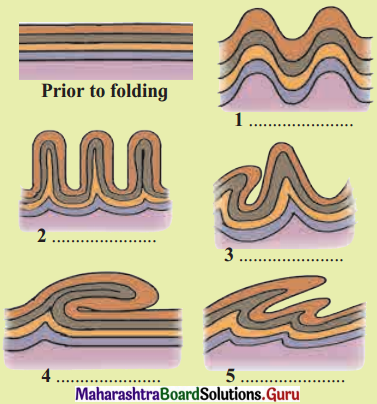
Answer:
- Symmetrical fold.
- Isoclinal fold
- Asymmetrical fold
- Recumbent fold
- Overturned fold
![]()
Question 2.
Observe the diagram in fig. 1.6 and read the explanation regarding the characteristics of various faults given. Identify the faults and match each of them with their characteristics. (Textbook Page No. 5)

Answer:
A – Normal fault B – Reverse fault C – Thrust fault D – Tear fault
Can you tell? (Textbook Page No. 7)
In fig 1.10 textbook page 6 A, B, C are three points on the earth’s surface. Analyse their location with respect to epicentre and shadow zones
Answer:
A, B, C are the points on the surface of the earth.
(i) ‘A’ point is located with 105° from the epicentre, therefore P waves and S waves reach at ‘A’ point. The seismograph at !A’ point records both waves, therefore ‘A’ point is not in shadow zone.
(ii) ‘B’ point is in shadow zone because both the waves do not reach there. P waves pass through all mediums, they experience refraction as they pass on one medium to another. The seismograph records P waves, which is located away from ‘B’ point. But P waves are not recorded in an area between 105 and 140° from epicentre. The S waves also do not reach here. Therefore, it is called ‘Shadow zone’ of Earthquake waves.
(iii) ‘C’ point is in the area of the shadow zone of ‘S’ waves, that in within 140°. P waves reach beyond 140°. Since ‘S’ waves do not reach here, it is called ‘Shadow zone of S waves’.
Question 1.
On the basis of the intensity of damage risk, India is classified into five risk zone. Use the given weblink http://www.bmtpc.org/DataFiles/CMS/file/map%20of%20india/eq-india. pdf and complete the table given. (Textbook Page No. 9)
Answer:
| Zone | Degree of Risk | States / UTs |
| I | Least | – |
| II | Low | – |
| III | Moderate | – |
| IV | High | Jammu & Kashmir. Himachal Pradesh, Uttarakhand, Sikkim, Parts of Indo Gangetic plains (North Punjab, Chandigarh, Western Uttar Pradesh) Delhi, Maharashtra, Bihar. |
| V | Very High | Region of Kashmir, Andaman and Nicobar island. |
![]()
Read the following passage about Krakatoa volcanic eruption and answer the following questions. (Textbook Page No. 10)
There is an island known as Krakatoa between the islands of Java and Su matra in Indonesia. There were frequent volcanic eruptions here. From May 1883, massive explosions began. The eruption that took place at about 10 in the morning on 28 August 1883 was the largest ever recorded explosion. As a result of this explosion, the entire island disappeared. During this eruption, rock particles and dust thrown up in the atmosphere was about 25 km³. The column of this dust-ash rose as high as 80 km.
The discharge of Krakatoa threw into the air nearly 21 km3 of rock fragments, and large quantities of ash fell over an area of some 800,000 km². Near the volcano, masses of floating pumice, were so thick that ships had to halt. The surrounding region was plunged into darkness for two and a half days because of ash in the air. For some years after this, cloud kept moving round the earth. About 36,000 people died in these eruptions and the tsunami waves created by it.
In 1927, volcanic eruptions began at the same place and a new island rose in place of the Krakatoa island that had vanished. It was named Anak Krakatoa’ or ‘Child Krakatoa’. The volcano here constantly emits ash and steam. This new island has now become a laboratory for geologists and biologists.
Question 1.
Make a list of materials that came out during eruptions.
Answer:
Rock, particles, dust, ash, floating pumice, steam were the materials that came out during eruption.
Question 2.
Classify them into liquid, solid and gaseous forms.
Answer:
| Liquid | Solid | Gaseous |
| Pumice | Rock particles | Steam |
| Dust | ||
| Ash |
Find out! (Textbook Page No. 9)
Find out examples of active, dormant and extinct volcanoes.
Answer:
Examples of active volcanoes are – Mt. Etna (Italy), Stromboli (Italy), Mt. Merapi (Indonesia), Erta Ale (Ethiopia), Mt. Erebus (Antarctica)
Examples of dormant volcanoes – Mt. Kilimanjaro (Africa), Mt. Katmai (Alaska)
Examples of extinct volcanoes – Mt. Egmont (New Zealand), Chimborazo (Ecuador), Mt. Kulal (Kenya)
![]()
Give it a try (Textbook Page No. 8)
Take the given hypothetical data in the table. The data shows the time of arrival of P-waves and S-waves at 3 seismograph stations. Assume the scale of the map as 1 cm : 18 km. See fig. 1.11.
| Recording Station | P-wave arrival time (IST) | S-wave arrival time |
| Jalana | 11 : 06 : 06 | 11 : 06 : 19 |
| Washim | 11 : 06 : 46 | 11 : 07 : 03 |
| Aurangabad | 11 : 07 : 06 | 11 : 07 : 24 |
Answer:
Speed of waves = 08 kms per second
Scale of the map = 1 cm
= 18 kms
First step : Find out the difference in time for waves at Jalana recording centre.
Difference in time of waves = Time of S-wave – Time of P-wave
11 : 06 : 19 (Time of S-wave)
11 : 06 : 06 (Time of P-wave)
= (Time of S-wave) – (Time of P-wave)
= 11 : 06 : 19 – 11 : 06 : 06
= 00 : 00 : 13
Therefore difference in time for waves at Jalana recording centre is 13 seconds.
Second Step : Find out distance on land between Jalana and Epicentre
Distance on land = Difference in time of waves × speed of waves per second
= 13 × 8
= 104
Therefore distance on land between Jalana and Epicentre is 104 km.
Third Step : Find out radius for Jalana Station.
Jalana – Radius of circle = \(\frac {Distance on land}{Scale of the map}\)
= \(\frac {104}{18}\)
= 5.7 cm.
Therefore radius of circle around Jalana station is 5.7 cm.
Now find out radium for remaing stations.
Jalana – 5.7 cm, Washim – 7.5 cm, Aurangabad – 8 cm.
![]()
Fouth step : Now draw circles around Jalana, Washim and Aurangad with the help of radius calculated.
All arcs of circle will intersect one another at a particular point. That point is the location of Epicentre.
In the map given below Epicentre is to the south of Mudgal.
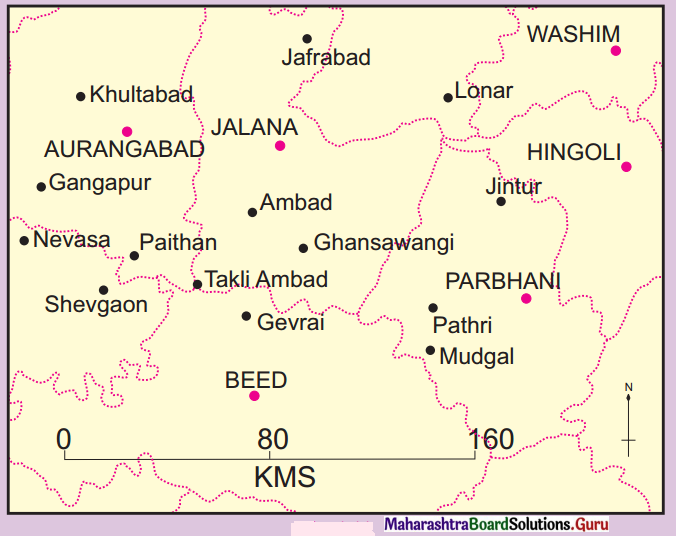
11th Std Geography Questions And Answers:
- Earth Movements Class 11 Geography Questions And Answers
- Weathering and Mass Wasting Class 11 Geography Questions And Answers
- Agents of Erosion Class 11 Geography Questions And Answers
- Climatic Regions Class 11 Geography Questions And Answers
- Global Climate Change Class 11 Geography Questions And Answers
- Ocean Resources Class 11 Geography Questions And Answers
- Indian Ocean – Relief and Strategic Importance Class 11 Geography Questions And Answers
- Biomes Class 11 Geography Questions And Answers
- Disaster Management Class 11 Geography Questions And Answers